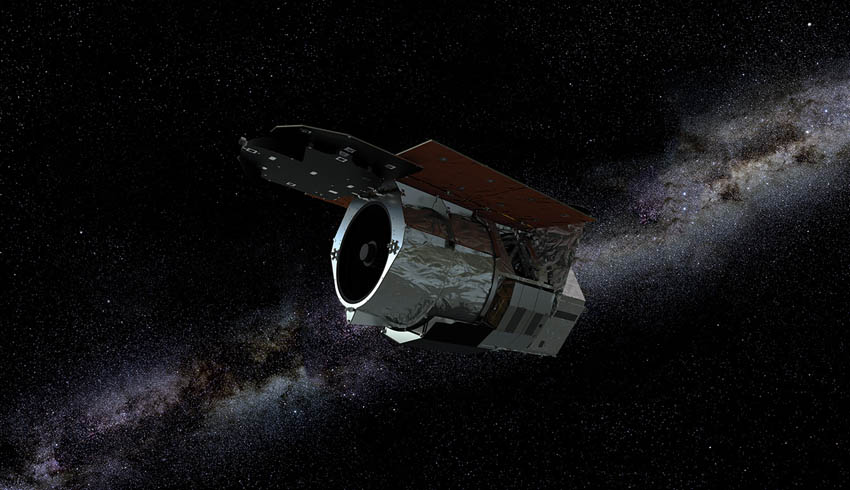This multilayered technology, the coronagraph instrument (might more rightly be called “starglasses”: a system of masks, prisms, detectors and even self-flexing mirrors) is built to block out the glare from distant stars and reveal the planets in orbit around them.
Normally, that glare is overwhelming, blotting out any chance of seeing planets orbiting other stars, called exoplanets, said Jason Rhodes, the project scientist for the Wide Field Infrared Survey Telescope (WFIRST) at NASA’s Jet Propulsion Laboratory in Pasadena, California.
A star’s photons – particles of light – vastly overpower any light coming from an orbiting planet when they hit the telescope.
“What we’re trying to do is cancel out a billion photons from the star for every one we capture from the planet,” Rhodes said.
And WFIRST’s coronagraph just completed a major milestone: a preliminary design review by NASA. That means the instrument has met all design, schedule and budget requirements, and can now proceed to the next phase: building hardware that will fly in space. It’s one of a series of such reviews examining every facet of the mission, said WFIRST project scientist Jeffrey Kruk of NASA’s Goddard Space Flight Center in Greenbelt, Maryland.
The WFIRST mission’s coronagraph is meant to demonstrate the power of increasingly advanced technology. As it captures light directly from large, gaseous exoplanets, and from disks of dust and gas surrounding other stars, it will point the way to technologies for even larger space telescopes.
Future telescopes with even more sophisticated coronagraphs will be able to generate single pixel “images” of rocky planets the size of Earth. Then the light can be spread into a rainbow called a “spectrum”, revealing which gases are present in the planet’s atmosphere – perhaps oxygen, methane, carbon dioxide, and maybe even signs of life.
“With WFIRST, we’ll be able to get images and spectra of these large planets, with the goal of proving technologies that will be used in a future mission – to eventually look at small rocky planets that could have liquid water on their surfaces, or even signs of life, like our own,” Rhodes said.
In this way, WFIRST is a kind of pioneer. That’s why NASA considers the coronagraph to be a “technology demonstration”. While it is likely to generate important scientific discoveries, its main job is to prove to the scientific community that complex coronagraphs really can work in space.
“This may be the most complicated astronomical instrument ever flown,” Rhodes said.
NASA’s Hubble Space Telescope, in orbit since 1990, is so far the only NASA astrophysics flagship mission to include coronagraphs – far simpler and less sophisticated versions than will fly on WFIRST.
But by the time it launches in the mid 2020s, WFIRST will be the third such mission to include coronagraph technology. NASA’s massive James Webb Space Telescope, launching in 2021, will include a coronagraph with a sharpness of vision greater than Hubble’s, but without the starlight suppression capability of WFIRST.
“WFIRST should be two or three orders of magnitude more powerful than any other coronagraph ever flown” in its ability to distinguish a planet from its star, Rhodes said. “There should be a chance for some really compelling science, even though it’s just a tech demo.”
Once the coronagraph technology is successfully demonstrated over the mission’s first 18 months, WFIRST’s coronagraph could become open to the scientific community. A “Participating Scientist Program” would invite a broader variety of observers to conduct experiments beyond the demonstration phase.
The coronagraph’s advancement through the design review milestone is part of a development schedule now moving at a fast clip. A giant camera that will also fly on the spacecraft, called the Wide Field Instrument, cleared the same hurdle in June. It is considered the space telescope’s main instrument.
Rhodes likes to compare WFIRST to the history-making Mars Pathfinder mission. After landing on the Red Planet in 1997, the Pathfinder lander unleashed a small rover, named Sojourner, to trundle on its own around the landing site and examine nearby rocks.
“That was a tech demo,” Rhodes said. “The goal was to show that a rover works on Mars. But it went on to do some very interesting science during its lifetime. So we’re hopeful the same is going to be true of WFIRST’s coronagraph tech demo.”

